Pistol Recoil Springs: The Ultimate Guide
 Bryan Hill / July 19 2024
Bryan Hill / July 19 2024
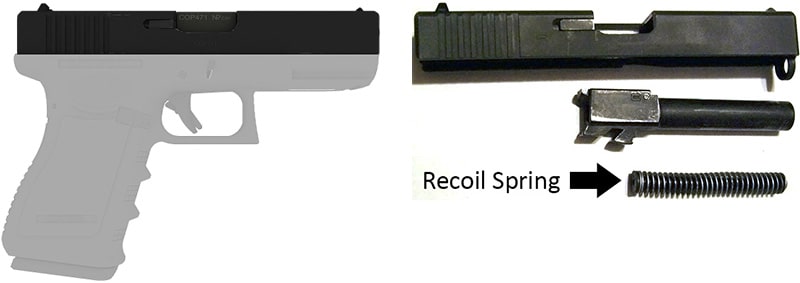
If you want to shoot faster or prevent jams, check out your pistol's recoil spring.
We'll cover how they work, how you can change them out for better performance,
when to replace a pistol recoil spring, alternatives, and whether you should upgrade your pistol's recoil spring.
On This Page:
- Basics
- Why Does a Good Recoil Spring Matter?
- What Makes a Good Recoil Spring?
- Captured vs. Non-Captured Recoil Assembly
- When to Replace Pistol Recoil Spring?
- Recoil Reduction Systems for Performance
- Recoil Buffers: Good or Bad?
- Recoil Springs and Slide Racking
- I Need a Custom Recoil Spring for My Pistol. What to do?
- Should I Upgrade My Recoil Spring?
- References
Basics
When you fire a loaded pistol, the slide
recoilsback:
The recoil spring then returns the slide forward:
This process is what reloads the pistol when you fire it.
The recoil spring sits inside the
slide,
underneath the
barrel,
and is held in place by a guide rod.
Recoil springs come in different weights and types. They affect:
-
Reliablility
-
Recoil sharpness
-
Muzzle rise in recoil
Why Does a Good Recoil Spring Matter?
The right recoil spring prevents jams and improves recoil for faster accurate shots.
What Makes a Good Recoil Spring?
The right spring load (AKA spring strength or spring weight) and durability matter most.
Spring load measures how much it takes to compress a spring a given distance. You can calculate it with this formula:
Load = Spring Rate * Travel (in inches)
Spring Rate = force or weight to compress the spring 1 inch.
So if you had a spring with a 10 lb. Spring Rate and compressed 1 inch, its Load would be 10 lb.
Compress it 2 inches, its Load is 20 lb.
Compress it 3 inches, its Load is 30 lb., and so on.
For pistol recoil springs, the listed load is for how much the spring compresses when the slide is locked back.
So a 20 lb. recoil spring takes 20 lb. of force to get the slide locked back, an 11 lb. spring takes 11 lb. to get the slide locked back, etc.
Recoil Spring is Too Strong
If your spring's load is too high, the slide will return with a snap, causing your sights to dip down after each shot instead of returning to the same spot.
It's like adding whiplash to your recoil.
In extreme cases, the slide won't fully travel back, and your pistol will fail to load itself. You'll get jams.
Another sign is that when firing, your brass ejects less than 6 ft.
You may get jams with:
-
An imperfect grip
-
A dirty or unlubed gun
-
Weak ammo
Why? When the gun is barely ejecting brass as it is, one thing goes wrong and that brass won't make it out.
Recoil Spring is Too Weak
A sign is that when firing, your brass ejects more than 8 ft.
The recoil will feel snappy coming back, which can be jarring if you don't have excellent grip strength and technique.
Even then, it's harder to track the sights in recoil.
In extreme cases, the slide will have so little force returning it that it won't return all the way or feed a new round. You'll get jams.
See it in action. A weak spring on the left, and a heavy spring on the right:
On the left, the pistol has plenty of time to cycle a new round. It's reliable, but takes longer to return to target.
On the right, the pistol cycles and returns to target faster, but risks jamming.
A better spring load for that pistol would be 13-14 lb.
See this video for more details:
Tuning Recoil Springs in Striker-Fired Guns
With striker fired pistols, the striker spring and the recoil spring have to be balanced.
If you change one too much, you may have to change the other in turn.
How do you know when to do this?
Test Your Recoil & Striker Spring Balance
-
Get a pistol and unload it.
-
Point it straight up. Put your focus on the slide.
-
Slowly press the trigger all the way until it dry fires.
-
If the slide moves relative to the frame, the recoil spring isn't balanced with the striker spring.
Let's say you saw the slide move. If you lightened your recoil spring, you'll have to also lighten your striker spring.
Here's an example with Gen 1-3 Glocks:
|
Part
|
OEM strength
|
Tuned strength for light rounds
|
|
Recoil Spring
|
17 lb.
|
13 lb. (ISMI Flat)
|
|
Striker Spring
|
5.5 lb.
|
4.5 lb. (Wolff)
|
The recoil spring got reduced to 76% of OEM, while the striker spring got reduced to 81%.
The balancing doesn't have to be perfect. It just needs to be enough to pass the test.
If you can't find aftermarket striker springs for your pistol, try Glock striker springs.
They're confirmed to work in S&W M&P, CZ P-10, Walther PPQ, P99, and Canik TP9 pistols.
Use the Glock spring cups ($5) with the Glock striker spring.
When you lighten your striker spring, your striker might fail to ignite the primer in some ammo.
If this happens, here's what you can do:
-
Get an extended and lightened striker. This design compensates for a lighter spring.
They can cost $40-90, but will save you time and frustration.
-
Make sure your striker channel is clean and smooth.
-
If you lube your striker channel, make sure it has a low Pour Point. Otherwise it can gum up in cold weather.
-
Change light striker springs more often. Many competitive Glock shooters change theirs every 3,000-5,000 rounds.
Some have reported no issues with changing them every 10,000-20,000 rounds.
Captured vs. Non-Captured Recoil Assembly
Captured Recoil Assembly

Captured recoil assemblies have two sides to the guide rod, with one being screwed on after installing the recoil spring.
They're easier to install and remove from a pistol. If you want to change out the spring, you'll have to unscrew the assembly.
That screw might need special tools to remove.
Uncaptured Recoil Assembly

Non-captured recoil assemblies have a guide rod with one side.
The recoil spring can slip on or off with ease, but while it's installed in the pistol, everything stays put.
Non-captured assemblies are harder to install or remove from a pistol, but usually it's just a few more seconds.
If you need to replace the recoil spring in a non-captured assembly, it's easy: just take it out and swap springs.
If you need to tune or maintain your recoil spring, this is the better choice.
When to Replace Pistol Recoil Spring?
There are two ways to tell.
First, look for issues. The most accurate way:
-
Your ejected casings fall some distance other than 6-8 ft away from you.
-
Your pistol fails to feed new rounds after recoil, and you've ruled out bad magazines as the cause.
If that doesn't work for you, replace your recoil spring on every X rounds fired, where X depends on the pistol's use.
Some examples:
-
2,000 rounds: Shooting nothing but overpressure (+P, +P+) ammo.
-
5,000 rounds: Carry gun.
-
10,000-20,000 rounds: Competition gun.
This second method is largely up to you. Some have reported 70k rounds without issues.
Unless you're a competitive or professional shooter, you probably won't have to replace your pistol's recoil spring due to wear.
Recoil Reduction Systems for Performance
There are a few ways to upgrade your recoil spring:
-
Mechanical recoil reduction system, that replaces your recoil spring and guide rod.
It reduces felt recoil and muzzle rise by 3-5%:
However, these take some tuning to prevent jams. You'll have to experiment with the different recoil springs provided:
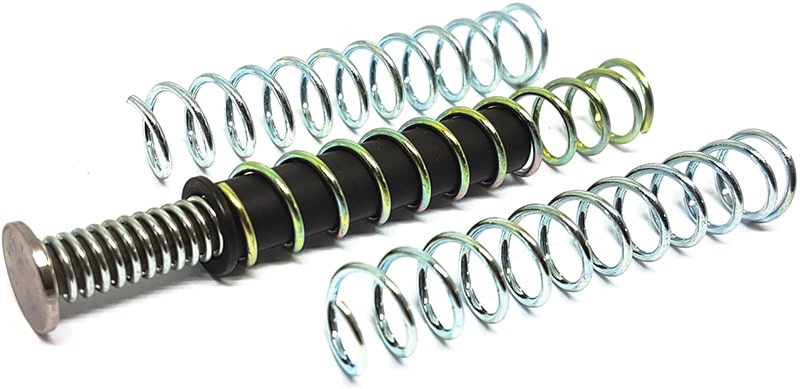
-
Tungsten guide rod, to add weight to the front of the pistol and reduce muzzle rise by 3-5%.
More weight in the pistol makes it less comfortable to carry.

Recoil Buffers: Good or Bad?
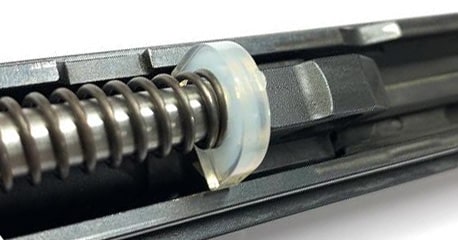
Some pistols, like the 2011 and CZ 75 series, come with a rubber or vinyl buffer pad.
What do they do, exactly? They:
-
Add load to your recoil spring, depending on thickness
-
Change the feel of the recoil
-
Reduce wear on some internal parts
Recoil Spring Load (or Weight)
Spring load increases with buffer pad thickness.
How? Think of how it is to load that last round in a magazine, compared to the 2nd last.
The buffer compresses the spring more when the slide is locked back compared to no buffer, or thinner buffers.
It makes the slide harder to rack all the way.
The CZ 75 series has a 4.6" barrel, while the Shadow 2 has a 4.9" barrel.
The space below the barrel for the recoil spring and guide rod is also about 0.3" longer for the Shadow 2.
A generic CZ 75 recoil spring functions at a lower weight in a Shadow 2,
because that extra space prevents the spring from compressing all the way. A buffer offsets that.
Recoil feel
It can take some shooting to notice it, but using a buffer is like using a dead blow hammer instead of a normal bare steel hammer - less vibration.
This probably won't affect your split times, but you may find shooting more pleasant.
Slide stop wear
On a CZ 75 or Shadow 2, a buffer reduces wear on the slide stop, but you don't need it.
A heavier recoil spring gets the job done about the same.
If your brass extracts 6-8 ft., you won't have excessive wear on that part.
Other points

Buffers wear out.
Overall lifetime depends on your ammo pressure, but for CZ pistols, thick buffers last around 5-15k rounds, while thin ones lasts 1-2k.
Too thick a buffer prevents the slide from going all the way back and extracting right.
The CZ thick buffer is fine on a Shadow 2, but not on a SP-01 or other CZ 75 models, even with a lighter recoil spring.
Any increase to your recoil spring's load affects extraction.
If you use a buffer, ensure your brass extracts 6-8 ft. to prevent jams.
If you're still unsure of whether to use a buffer or not, and your gun came with one,
try it out and test your extraction.
If it's 6-8 ft., keep it in and see if you prefer it.
If it's less than 6 ft., remove the buffer.
If it's still under 6 ft. (due to low-pressure ammo, or a compensator),
use a lighter recoil spring and start over.
Recoil Springs and Slide Racking
Having trouble racking the slide? Reducing the recoil spring's load will help. You can usually reduce it by 2-4 lb. without any major drawbacks.
To reduce your load further, adding a
compensator requires a
recoil spring around 2-4 lb. lighter to prevent jams.
It costs extra and takes some time to get it working right, but it'll also reduce recoil 25-40%.
I Need a Custom Recoil Spring for My Pistol. What to do?
Double-Check Retailers First
Need a replacement spring for your pistol? Here are some starting points:
Repurposing Parts
If you can't get the recoil spring you need for your gun, you might get what you need from an aftermarket Glock recoil spring or assembly, as they come in a variety of spring loads.
Glock 26, 19, 17, and 34 recoil springs all have an Outer Diameter of 13mm.
If a Glock spring's Outer Diameter is equal or less than your pistol's recoil spring, it will work with little fitting.
If the Outer Diameter is larger, the spring may grind against the inside of the frame, or it won't fit on the recoil assembly.
If the Outer Diameter is too small, the spring may grind against the recoil guide rod.
Check your pistol's recoil assembly to get an idea of what size of spring would fit.
Pick a Glock model of the same overall size as your pistol. For 9mm pistols:
If Your Pistol's Recoil System is Easy to Disassemble
You're lucky. You can just swap out the recoil spring in your pistol with a Glock recoil spring with the load you need.
You'll have have to cut some coils to get the springs to match in size. Sand the cut tip to make it not sharp.
If you'd like to square-up the end, then cut to 1 extra coil of length. Heat up that extra coil with a propane torch till it's red-hot, then press the coil into a steel block for 4 seconds.
For example, you may have a pistol with an uncaptured guide rod and recoil spring with a free length of 4".
If you get a Glock spring with the load you need and its free length is 4.25" long, you'll have to cut coils so it's 4" long or else the spring will over-compress in a space smaller than what it was designed for.
If Your Pistol Uses a Captured Guide Rod You Can't Disassemble
In this case you'll then have to fit the Glock part(s) to your gun.
This means sanding down parts of the Glock recoil assembly or guide rod so it matches up with your gun's OEM parts.
There's no guarantee things will work out, so call your local gunsmith first and run your plan by them before you order any parts.
Options other than Glock
If your pistol's recoil spring Outer Diameter is less than 13mm, other pistols have great aftermarket support for recoil springs:
-
Sig p226, p220, p225
-
Smith & Wesson M&P Series (Outer Diameter: 10.7mm)
-
CZ 75 series (Outer Diameter: 9.7mm)
Again, you'll probably have to cut coils so the spring length matches your pistol's recoil springs.
But otherwise if the outer diameter isn't too big and it fits in the guide rod, you're good to go.
Lightening an OEM Spring
If Glock (or CZ, Sig, etc.) springs can't be repurposed, you can take an OEM spring to a gunsmith to lighten it.
You can also do it yourself if you have a bench grinder and some other tools:
To find how much to grind, use the Recoil Spring Calculator below, first plugging in your spring's dimensions.
Then play with the wire diameter in the calculator until you get the Spring Load you need.
If this all seems daunting, your local gunsmith can take care of it.
If all these options don't apply, here's how to special order your own.
Sure You Need a Custom Spring? Know This
It costs about as much to fabricate 1 spring ($250) as it does to make 5 or more.
If you balk at the price of a single custom spring,
then I recommend finding at least 9 other people who need the same spring as you so you can pool your money (include shipping) and do a bulk order.
Check forums for your pistol, call local gunsmiths, and any other group that may use the pistol you're ordering springs for.
The more people you get on board, the closer you get the cost per spring to what you'd pay for a mass-market recoil spring.
Replacing a Spring of the Same Load
-
Get a caliper. Don't have one? I've used a few and prefer the
NEIKO 01407A.
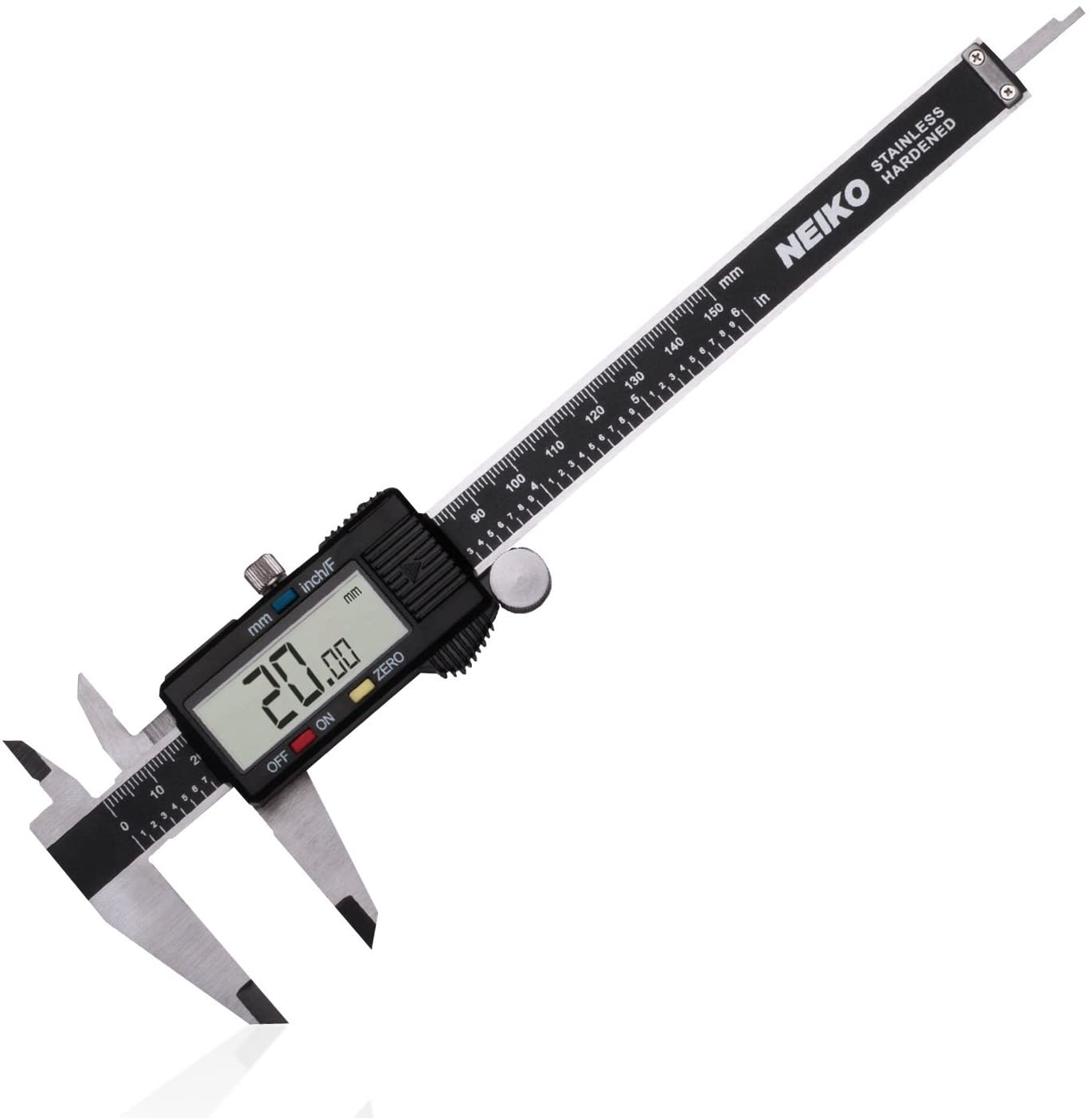
Precise measurements are paramount. Being off by 0.01" on wire diameter can have a big effect on your spring load.
-
Measure out your pistol's recoil spring dimensions and write them down:
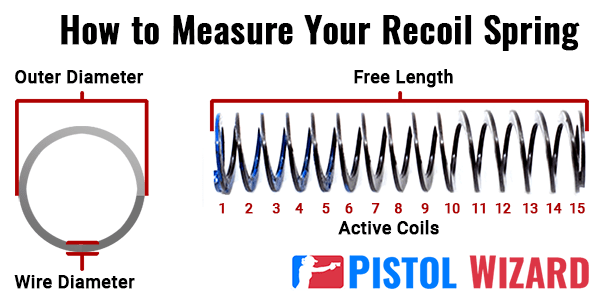
-
Free Length: total length of the spring when it's not compressed.
-
Outer Diameter: overall diameter of the spring.
-
Wire Diameter: diameter of the spring wire.
-
Active Coils: count the total coils and subtract 2.
-
Go to Murphy & Read Spring and order your spring, plugging in the measurements.
For the spring material, choose music wire.
That's the best material for recoil springs, except for a few applications.
For the spring ends, check your recoil spring.
Closed & square are by far the most common, followed by Closed & Ground.
Be aware the price starts around $250 for 1 spring, but the cost to add more springs is minimal.
Ordering a Spring of a Different Load
When you need springs of a different strength than what's available, here's what you do:
-
Measure out your pistol's recoil spring dimensions
with calipers
and write them down, as though you were replacing the spring (see above instructions and infographic).
-
Plug the measurements into this recoil spring calculator:
-
Don't have the precise Compressed Length of your recoil spring? Here's how to get it:
-
Lock your slide back. Measure how far the slide travelled from the end of the frame.
Add 0.125 (the slide travels a little further than its locked-back state).
The total is your Slide Travel.
-
Remove the slide from your pistol. Measure the recoil spring's length while installed in the slide.
That's your Installed Length.
-
Compressed Length = Installed Length - Slide Travel
Once you have your recoil spring's specs measured out, tweak the spring design for your desired spring Load(s) compared to your spring's Load.
If your recoil spring fits tight on the guide rod, change the Active Coils.
Otherwise, change the Wire Diameter.
-
Go to Murphy & Read Spring and order your spring, plugging in the measurements.
For the spring material, choose music wire.
That's the best material for recoil springs, except for a few applications.
For the spring ends, check your recoil spring.
Closed & square are by far the most common, followed by Closed & Ground.
Be aware the price starts around $250 for 1 spring, but the cost to add more springs is minimal.
I am NOT an affiliate for Murphy & Read Spring! I don't make a dime off of them or my custom recoil spring calculator!
I contacted over 10 spring companies and Murphy & Read Spring offered the fastest response and the best quote.
This is purely for your benefit.
Should I Upgrade My Recoil Spring?
The stock recoil spring on your pistol will work great in most cases.
Only change recoil springs when you:
-
Do not get 6-8 ft. of brass extraction with your preferred ammo
(Reducing the spring load by 1 lb. adds 1.5-2.0 ft of ejection, and vice versa. If you need 3-4 more ft of ejection, try a spring 2 lb. lighter)
-
Notice your pistol jams with your preferred ammo
-
Have trouble racking the slide
-
Add a compensator or ported barrel to your pistol
-
Change your slide weight for performance
-
Shoot competitively and want to get every bit of performance you can
There are many ways to reduce recoil, and there are better options for the level of hassle.
Related Articles
Feedback
Are you happy with this page?
References
-
Glock with 13 lb recoil spring: change striker spring also @ minor PF? (2021)
-
Using 1911 Recoil Springs in your Sig Sauer P320 (2021)
-
Understanding Spring Load and Its Relation to Spring Rate (2020)
-
How to Select the Proper Recoil Spring (2019)
-
Test: Slow Motion | DPM Triple Spring Mechanical Recoil Reduction System | Glock 17 C Gen 4 (2019)
-
Recoil Buffers and Competition (2019)
-
Shadow 2 Recoil Pad (2019)
-
Simple Method Adjusting & Weakening A Compression Spring (2018)
-
My Shadow 2 Modifications (2018)
-
Shadow 2 Buffer - When to Replace? (2018)
-
Tuning your Pistol for Faster Double Taps with Recoil Springs (2017)
-
How often we need to change springs? (2017)
-
When to replace recoil spring - and how to know (2017)
-
Understanding Spring Load and Its Relation to Spring Rate (2015)
-
When to change recoil spring, main spring Tactical Sport (2015)
-
DPM Recoil Reduction System Test Result (2010)